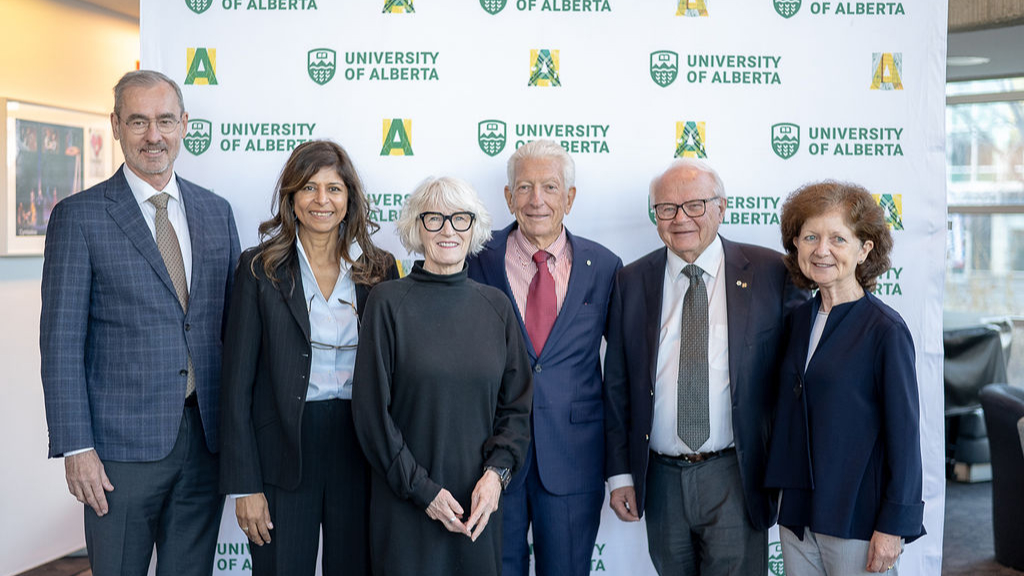$5 million donated to augment cardiovascular research at the U of A
Karen Kwan - 18 March 2024

President Bill Flanagan, Narmin Kassam, Chancellor Peggy Garritty, Paul Armstrong, Lorne Tyrrell and Brenda Hemmelgarn
A new research chair in cardiovascular science in the Faculty of Medicine & Dentistry will help drive advancements in research and improve health outcomes for patients.
The initiative is funded by a $5-million donation from the CVC Cardiovascular Health Foundation, with the goal of elevating the CVC at the University of Alberta to the “next level,” says Paul Armstrong, the Canadian VIGOUR Centre’s founding director and U of A distinguished professor of medicine.
Armstrong says he’s looking for a research chair who will bring “talent, energy, excitement and experience” to advance the centre’s work in cardiovascular research and clinical trials.
The endowment will not only support research but will also boost collaboration across disciplines within the Faculty of Medicine & Dentistry, the College of Health Sciences and other agencies. “We say research is a team sport,” Armstrong says. He applies that same principle to the larger health-care system, including pharmacists, dieticians and social workers who contribute to patient care, along with doctors and nurses. “Patients do better if they’re being cared for by a team of people.”
Narmin Kassam, chair of the U of A’s Department of Medicine, says the establishment of an endowed chair embodies that collaborative spirit and allows the university to build on its long history of achievement in medical knowledge and advancement.
“Today’s generous donation is not just an investment in our future — it’s a testament to a century of unwavering commitment from the Department of Medicine to advancing health, education and patient care,” she says.
When it comes to medical research, the end goal is, of course, to improve patient outcomes. That’s why translational research — turning new discoveries into effective and accessible treatments as soon as possible — is a top priority. A collaborative approach between cardiovascular researchers and other scientists during the early stages of research could lead to more effective therapies, Armstrong says.
“We know there’s a special biomarker that is emitted from the heart if the heart is under duress or stress. There’s another one that’s emitted if there’s damage,” he explains. By analyzing data and how it relates to different populations, Armstrong says researchers can develop more targeted treatments and potentially save more lives.
Together, the Canadian VIGOUR Centre and the U of A foster the ideal environment for turning research into real-world applications, Armstrong points out. The university is known as a leader in cardiovascular medicine and other sciences, and boasts strong epidemiology and public health departments, while the CVC has a strong track record of initiating clinical trials and analyzing and sharing data. It’s a matter of “putting all the pieces together,” he says.
The not-for-profit CVC was established in 1997 and has since become successful in generating revenue from its work. Part of that money is being used to fund the $5-million endowment through the CVC Foundation.
The mandate of the new chair extends far beyond the U of A campus and the province. One of the key roles is to expand research partnerships nationally and internationally, with the CVC having already worked with institutions around the world, including the Duke Clinical Research Institute and others in the United States, Belgium, Sweden, Singapore and Australia.
The ideal candidate will attract other researchers and develop a network of mentors for young scientists, something Armstrong believes is essential for those embarking on a research career.
Armstrong, a pioneer in cardiology and an internationally renowned expert in acute coronary disease and heart failure, has had a long and distinguished career. He has received numerous accolades, among them Officer of the Order of Canada and the University of Alberta Cup. He says support from mentors throughout his journey played a critical role in his success, especially early in his career.
Over the past quarter century, the CVC’s efforts have helped save many lives, reducing heart attack mortality rates from 30 per cent to just five per cent. More recently, a new oral drug that’s shown to lower death and hospitalization rates for some patients with chronic heart failure is now available, thanks in part to international clinical trials led by the CVC.
“It’s gratifying to see patients doing well and better than they did before,” Armstrong says. He expects the new research chair will spearhead further transformational work.
The research chair will be recruited from outside the U of A to bring a fresh perspective, Armstrong says. He believes that “the attitudinal shifts, the excitement that will be generated, will make a lot of good things happen.
“That would be my definition of a wonderful return on our investment.”